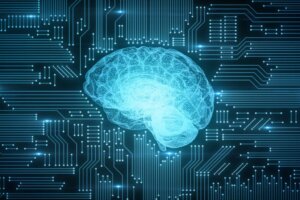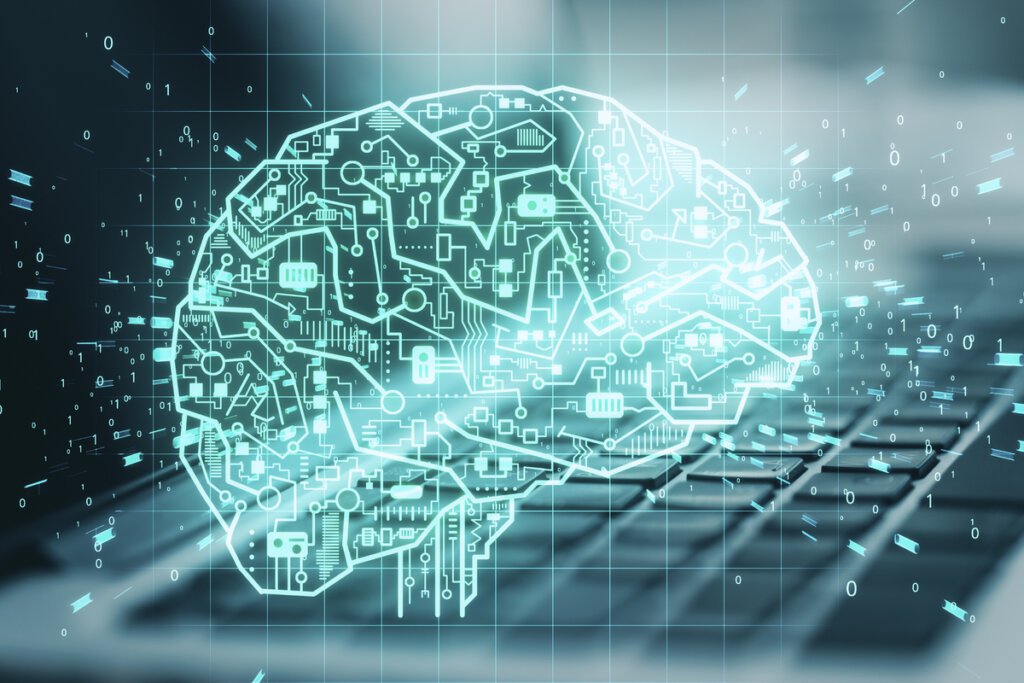The Computational Theory of Mind


Written and verified by the psychologist Sergio De Dios González
Since ancient times and, presumably, before, as humans, we’ve wondered what makes us different from other animals. This has led us to speculate on the nature of what we now call the mind. In fact, numerous explanatory models have been created in an attempt to understand this entity. One of them is the computational theory of mind. It claims that the human cognitive system is a computational system.
According to the computational theory of mind, people process, transform, encode, store, retrieve, and use information in the same way that a computer does. If you want to know more about this explanatory model, read on.
The computational theory of mind
Also known as computationalism, this theory is a set of explanations that suggests that the human mind is an information-processing system and that cognition and consciousness are a form of computation.
Indeed, according to this theory, the mind takes information from the environment (input), processes it, transforms it, and generates a response (output) through an algorithmic process. In this sense, thought is compared to a calculation or, more precisely, to the application of a certain system of rules.
That said, the computational theory of mind holds that the mind isn’t simply analogous to a computer program but is, literally, a computational system.
Of course, the most familiar artificial computing systems are made of silicon chips or similar materials, while the human body is made of flesh and blood. However, this theory maintains that, behind the physical difference, there’s a fundamental similarity: operations are carried out via computations.

The background to the computational theory of mind
The foundations of the computational theory of mind can be summarized as:
Mathematical formalism
Intuitive notions of computation and algorithms are fundamental to mathematics. In general terms, an algorithm is an explicit procedure to answer a specific question or solve a problem. An algorithm provides routine mechanical instructions, dictating how to proceed at each step.
Obeying their instructions doesn’t require ingenuity or special creativity. For example, familiar elementary school algorithms describe how to carry out addition, multiplication, and division. Therefore, mathematics can be considered one of the first disciplines to work on computation or calculation.
The Turing machine
A Turing machine is a theoretical model of a computer, which has unlimited computation time and storage space at its disposal. The device manipulates symbols, in the same way that the human manipulates information during arithmetical calculations.
According to computationalism, the mind is a computational system similar to a Turing machine. It claims that the core mental processes (such as reasoning, decision-making, and problem-solving) are calculations similar to those executed by such a machine.
Physicalism
Physicalism is a philosophical theory on the nature of reality. It defends that what exists is exclusively physical. It also reduces the mental aspect to this level. Therefore, it sees mental processes as an epiphenomenon of the brain. This means the mind is understood when science is sufficiently developed to understand brain activity.
Representatives
Warren McCulloch and Walter Pitts (1943) were the first to suggest that neural activity is computational. In fact, they argued that neural computations explain cognition.
However, the computational theory of mind was proposed by Hilary Putnam in 1967. It was later developed by her doctoral student, philosopher, and cognitive scientist Jerry Fodor, during the 1960s, 70s, and 80s.
Principles of the computational theory of mind
To better understand the computational theory of mind, here are some of its basic principles:
- The human mind is a system that sequentially processes symbolic information, based on a set of calculation rules (algorithms).
- Computers and human cognitive systems receive, encode, transform, store and retrieve information based on computational rules.
- The human mind and artificial intelligent systems (such as the computer) are structurally different but functionally equivalent.

Critics
The computational theory of mind has received numerous criticisms, particularly from philosophers John Searle, Hubert Dreyfus, and Roger Penrose. These center around the reduction of thought and understanding to the simple application of a system of rules.
For example, for Searle, the mind isn’t reduced to the simple manipulation of symbols (grammar or syntax), but also has a semantic capacity to realize or be aware of the meanings of symbols. This is what differentiates us from artificial intelligence.
On the other hand, Hubert Dreyfus asserts that intuitive, creative, or skillful human activity seems to resist formalization by a computer program. For example, could a computer compose the Eroica symphony? Could it discover general relativity? Or, could it replicate a child’s effortless ability to perceive the environment, tie their shoelaces, and discern the emotions of others?
Since ancient times and, presumably, before, as humans, we’ve wondered what makes us different from other animals. This has led us to speculate on the nature of what we now call the mind. In fact, numerous explanatory models have been created in an attempt to understand this entity. One of them is the computational theory of mind. It claims that the human cognitive system is a computational system.
According to the computational theory of mind, people process, transform, encode, store, retrieve, and use information in the same way that a computer does. If you want to know more about this explanatory model, read on.
The computational theory of mind
Also known as computationalism, this theory is a set of explanations that suggests that the human mind is an information-processing system and that cognition and consciousness are a form of computation.
Indeed, according to this theory, the mind takes information from the environment (input), processes it, transforms it, and generates a response (output) through an algorithmic process. In this sense, thought is compared to a calculation or, more precisely, to the application of a certain system of rules.
That said, the computational theory of mind holds that the mind isn’t simply analogous to a computer program but is, literally, a computational system.
Of course, the most familiar artificial computing systems are made of silicon chips or similar materials, while the human body is made of flesh and blood. However, this theory maintains that, behind the physical difference, there’s a fundamental similarity: operations are carried out via computations.

The background to the computational theory of mind
The foundations of the computational theory of mind can be summarized as:
Mathematical formalism
Intuitive notions of computation and algorithms are fundamental to mathematics. In general terms, an algorithm is an explicit procedure to answer a specific question or solve a problem. An algorithm provides routine mechanical instructions, dictating how to proceed at each step.
Obeying their instructions doesn’t require ingenuity or special creativity. For example, familiar elementary school algorithms describe how to carry out addition, multiplication, and division. Therefore, mathematics can be considered one of the first disciplines to work on computation or calculation.
The Turing machine
A Turing machine is a theoretical model of a computer, which has unlimited computation time and storage space at its disposal. The device manipulates symbols, in the same way that the human manipulates information during arithmetical calculations.
According to computationalism, the mind is a computational system similar to a Turing machine. It claims that the core mental processes (such as reasoning, decision-making, and problem-solving) are calculations similar to those executed by such a machine.
Physicalism
Physicalism is a philosophical theory on the nature of reality. It defends that what exists is exclusively physical. It also reduces the mental aspect to this level. Therefore, it sees mental processes as an epiphenomenon of the brain. This means the mind is understood when science is sufficiently developed to understand brain activity.
Representatives
Warren McCulloch and Walter Pitts (1943) were the first to suggest that neural activity is computational. In fact, they argued that neural computations explain cognition.
However, the computational theory of mind was proposed by Hilary Putnam in 1967. It was later developed by her doctoral student, philosopher, and cognitive scientist Jerry Fodor, during the 1960s, 70s, and 80s.
Principles of the computational theory of mind
To better understand the computational theory of mind, here are some of its basic principles:
- The human mind is a system that sequentially processes symbolic information, based on a set of calculation rules (algorithms).
- Computers and human cognitive systems receive, encode, transform, store and retrieve information based on computational rules.
- The human mind and artificial intelligent systems (such as the computer) are structurally different but functionally equivalent.

Critics
The computational theory of mind has received numerous criticisms, particularly from philosophers John Searle, Hubert Dreyfus, and Roger Penrose. These center around the reduction of thought and understanding to the simple application of a system of rules.
For example, for Searle, the mind isn’t reduced to the simple manipulation of symbols (grammar or syntax), but also has a semantic capacity to realize or be aware of the meanings of symbols. This is what differentiates us from artificial intelligence.
On the other hand, Hubert Dreyfus asserts that intuitive, creative, or skillful human activity seems to resist formalization by a computer program. For example, could a computer compose the Eroica symphony? Could it discover general relativity? Or, could it replicate a child’s effortless ability to perceive the environment, tie their shoelaces, and discern the emotions of others?
All cited sources were thoroughly reviewed by our team to ensure their quality, reliability, currency, and validity. The bibliography of this article was considered reliable and of academic or scientific accuracy.
- Rescorla N. Computational Theory of Mind [Internet]. California: Stanford Encyclopedia of Philosophy; 2020 [consultado 12 agosto 2021]. Disponible en: https://plato.stanford.edu/entries/computational-mind/
This text is provided for informational purposes only and does not replace consultation with a professional. If in doubt, consult your specialist.







